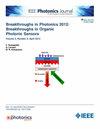Realization of Electrically Driven AlGaN-Delta-GaN QW DUV Micro-LEDs at 265 nm
IF 2.4
4区 工程技术
Q3 ENGINEERING, ELECTRICAL & ELECTRONIC
引用次数: 0
Abstract
Quantum efficiency of deep-ultraviolet (DUV) light-emitting diodes (LEDs) is a roadblock for these devices to reach efficiencies comparable to their visible light counterparts. The main contributing factor limiting the internal quantum efficiency (IQE) are the effects of the quantum confined Stark effect (QCSE) and valance subband crossover, which can be mitigated through engineering of the quantum well (QW) active region. This work represents the first fabrication and testing of novel full structure electrically driven AlGaN-delta-GaN QW DUV micro-LEDs (265 nm电驱动AlGaN-Delta-GaN QW DUV微型led的实现
深紫外(DUV)发光二极管(led)的量子效率是这些设备达到与可见光相当的效率的障碍。限制内量子效率(IQE)的主要因素是量子受限斯塔克效应(QCSE)和价子带交叉的影响,可以通过工程设计量子阱(QW)有源区来缓解。这项工作代表了新型全结构电驱动AlGaN-delta-GaN QW DUV微型led ($\mu$ led)的首次制造和测试,其表面尺寸在10 $\mu$m到30 $\mu$m之间。电气测试显示,导通电压约为5-6 V,串联电阻占主导的阈值后特性。10 $\mu$m × 10 $\mu$m和30 $\mu$m × 30 $\mu$m $\mu$m的发光峰分别位于262 nm和264.5 nm,发光线宽分别为7.1 nm和13.6 nm。功率测量显示,光输出功率密度从100 A/cm$^{2}$时的50 mW/cm$^{2}$增加到800 A/cm$^{2}$时的近400 mW/cm$^{2}$。对于30 $\mu$m × 30 $\mu$m器件,效率下降发生在83 A/cm$^{2}$,对于10 $\mu$m × 10 $\mu$m器件,效率下降发生在200 A/cm$^{2}$。总体结果表明,AlGaN-delta-GaN QW有源区可以提高DUV发光led的IQE和光提取效率,并且可以证明是传统设计的可行替代方案。
本文章由计算机程序翻译,如有差异,请以英文原文为准。
求助全文
约1分钟内获得全文
求助全文
来源期刊

IEEE Photonics Journal
ENGINEERING, ELECTRICAL & ELECTRONIC-OPTICS
CiteScore
4.50
自引率
8.30%
发文量
489
审稿时长
1.4 months
期刊介绍:
Breakthroughs in the generation of light and in its control and utilization have given rise to the field of Photonics, a rapidly expanding area of science and technology with major technological and economic impact. Photonics integrates quantum electronics and optics to accelerate progress in the generation of novel photon sources and in their utilization in emerging applications at the micro and nano scales spanning from the far-infrared/THz to the x-ray region of the electromagnetic spectrum. IEEE Photonics Journal is an online-only journal dedicated to the rapid disclosure of top-quality peer-reviewed research at the forefront of all areas of photonics. Contributions addressing issues ranging from fundamental understanding to emerging technologies and applications are within the scope of the Journal. The Journal includes topics in: Photon sources from far infrared to X-rays, Photonics materials and engineered photonic structures, Integrated optics and optoelectronic, Ultrafast, attosecond, high field and short wavelength photonics, Biophotonics, including DNA photonics, Nanophotonics, Magnetophotonics, Fundamentals of light propagation and interaction; nonlinear effects, Optical data storage, Fiber optics and optical communications devices, systems, and technologies, Micro Opto Electro Mechanical Systems (MOEMS), Microwave photonics, Optical Sensors.
 求助内容:
求助内容: 应助结果提醒方式:
应助结果提醒方式:


